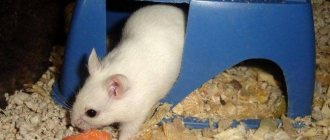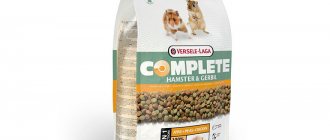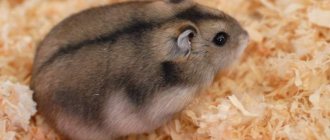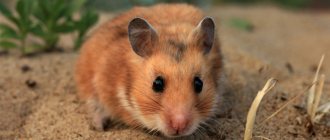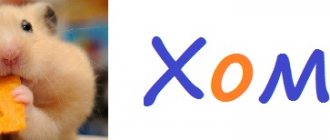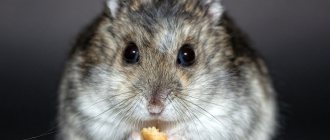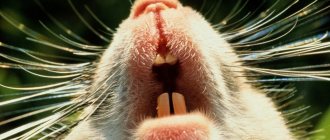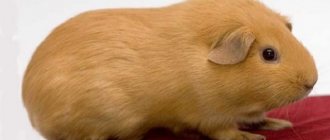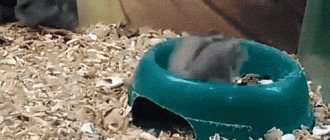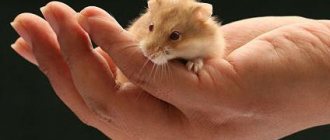Many will agree that hamsters are the most interesting and beloved pets. It is not difficult to find an explanation for this: the extreme unpretentiousness of the animals and their amusing appearance will attract the attention of even the most indifferent person. Children have a special liking for them. Small, nimble and funny, hamsters themselves resemble stupid children.
Most often, Djungarian hamsters are kept at home: a tiny rodent with beautiful fur that changes color depending on the time of year - ideal for any apartment. In addition, unlike its relatives, the hamster is exceptionally clean and does not emit a characteristic odor. Despite this, it is recommended to clean the cage regularly.
Djungarian hamsters are very attached to their owner and love to be petted and picked up. Rodents are extremely active and cannot sit in their house “idly”, so it is recommended to arrange the home of the jungarian in such a way that he does not get bored.
Origin of Djungarian hamsters
The first mention of the Djungarian breed of hamsters appeared in the works of the German scientist P.S. Pallas in 1773. This researcher described the characteristics of the animal. In the middle of the 19th century. The first successful attempts were made to domesticate these representatives of the fauna. At the beginning of the 20th century. In Europe, keeping rodents at home has become popular, which has contributed to an increase in the population of these animals.
All hamsters currently bred in captivity are descended from a small number of wild-caught individuals.
This contributed to the emergence of mutations, incl. causing coat colors uncharacteristic for the breed. Subsequently, through breeding work, new colors were fixed at the genetic level.
Description of the breed
Djungarian hamsters are small, furry animals with a pointed muzzle and small ears. These creatures are active and inquisitive. Many people try to change their coat color, believing that such animals have better health. However, there are breeders who prefer pets of exotic colors.
Habitat
The homeland of Djungarian hamsters is the wormwood, xerophytic, gravelly-cinquefoil, and cereal-desert zones of North-Eastern Kazakhstan, Khakassia, and Western Siberia. Representatives of the breed also live in Altai. They can rarely be found in the steppe zones of the USA and Canada, but in these regions the wild population originated from pets brought from Europe, which people released into the natural environment.
Wild hamsters living in steppes and deserts are forced to obtain their own food, so their diet includes many types of food.
Rodents try to stay away from people, but when there is a lack of food in their natural environment, they raid agricultural land.
Coat color and length
Under natural conditions, the color of an animal's coat changes throughout the year. In spring and early summer, the fur on the back of the rodent is dark gray. At the same time, the abdomen remains beige. As the vegetation dies by the beginning of autumn, the fur acquires a pearl color.
In winter, the fur on the back becomes grey-white. This breed is characterized by a stripe of dark fur running along the spine and extending to the head. Changing colors helps animals protect themselves from predators. The length of the coat does not exceed 1 cm. There is a dense undercoat that protects the rodent from the cold. When kept at home, the color of the pet's fur does not change.
Color options for Djungarian hamsters.
Length and weight
Djungarians are small rodents whose body length is on average 7-15 cm. However, in the population there are smaller individuals that grow to 5-6 cm by the time of puberty.
The animal does not weigh the same throughout the year. In winter, it quickly loses weight, and in spring and summer it gains fat, even if the rodent lives in captivity and receives a sufficient amount of food every day. The weight of females is 19-36 g, and males - 19-45 g.
Character and lifestyle
In their natural environment, hamsters are nocturnal to avoid predators. Rodents dig holes or occupy others, often making nests in rock crevices. The animals spend most of the day in their shelter. Representatives of the species make provisions for the cold season.
Domesticated animals have largely retained the habits of their wild relatives. They are most active at night and can carry food into their house to stock up in case of a hungry period. These animals fiercely defend their territory. The fights between them are fierce.
The rodent is distinguished by its friendliness towards humans. The animal quickly gets used to its owner and begins to respond to its name. Loves stroking. You can accustom the animal to regular combing of its fur. Some pets fall asleep easily in your arms.
Djungarians love to be petted.
Lifespan
In their natural environment, these animals often die at a young age due to lack of food and attacks by predators. In captivity, they live on average about 2-3 years. However, if you provide the rodent with proper care, it can please its owner for 4 years.
Types of Dzungars and their prices
Unlike other breeds of hamsters, Djungarian hamsters are not divided into short-haired and long-haired . Their fur is equally thick and the hairs are of medium length. Among Djungarian hamsters, there are decorative varieties obtained through selection that differ in color. There are red, sapphire and pearl-white individuals of decorative dzhungarikas. Specially bred hamsters are more expensive than regular ones, sometimes twice their price. For them the buyer will have to pay about 500-1000 rubles .
Decorative hamsters are more demanding in terms of living conditions, are susceptible to stress and are less resistant to disease.
Selection and arrangement of the cage
There are special requirements for the selection and arrangement of the cage.
It should contain:
- "sports" zone;
- feeding area;
- shelters.
Many breeders also recommend installing a “dry” bath inside the cage. Rodents love to rub against sand to clean their fur and remove dead hairs during shedding.
Requirements
Djungarian hamsters are small, but they require a lot of space. The minimum size of the cage bottom is 55x30 cm. However, it is better to have twice as much space. You can buy a two-tier cage with metal bars. The pallet must be plastic or wooden. It is unacceptable to have a mesh on the bottom, because... getting a rodent's claw or finger into the cell will cause injury. It is desirable that the tray be removable.
The hamster cage should be as large as possible, at least 55x30 cm.
In the cage, you must install a resting house made of hay, special labyrinths and holes of different heights and shapes, as well as several snags under which the pet can retire or hide food.
Sports area
The hamster has a fast metabolism, so if the animal does not move a lot, its fat layer will begin to increase. Excess weight is extremely dangerous for the health of these animals.
In natural conditions, rodents travel up to 10 km a day, so it is important to properly set up a sports area in the cage. Hamsters love to run on wheels. Its diameter must be at least 16 cm. It is better if the wheel is solid so that the animal’s paws do not fall between the bars.
Eating area
The arrangement of the eating area also needs to be given special attention. As a feeder, you can use a metal container up to 2 cm deep. It is important that it is heavy enough. In this case, the animal will not be able to turn it over. Hanging plastic feeders are also convenient. They are attached to the bars of the cage, so the rodent will not be able to move them.
If the hamster receives succulent food every day, it is not necessary to install a container of water.
However, when eating dry grains, the animal may feel thirsty. It is better to install a mounted drinking bowl so that the rodent does not turn it over and wet the bedding.
Carrying and necessary accessories
For a hamster, a simple metal or plastic carrier with a length of at least 15 cm will be sufficient. This device is useful when visiting a veterinary clinic. In addition, you can place the animal here while cleaning the cage.
A hamster carrier is an important thing that you can’t do without.
The required minimum of auxiliary accessories includes a walking ball. While wearing it, your pet will be able to safely walk throughout the house. In addition, it is advisable to buy a teeth sharpener made from compressed grass.
Cleaning
Wood pellets or dry grass can be used as bedding. The filler layer should be at least 3 cm. A removable tray will make it easier to keep the cage clean. Every day you need to remove the remains of succulent feed. It is recommended to change the litter once every 2 weeks. Hamsters often only defecate in one corner. Only the contaminated part of the filler should be replaced. Preserved supplies and the smell of the animal remaining on the bedding will help the rodent avoid stress.
Examples of the cost of Siberian hamsters
The Dzungarian breed is relatively small, so representatives of this species are a little more expensive. If you buy a Djungarian hamster at a pet store, you can also purchase a cage at the same time. An ordinary gray jungar, 1 month old, including a cage, will cost about 600-700 rubles . But this price is only relevant if the cage is for transportation. If you buy a decorative cage with a hamster, the purchase will cost 3,000-10,000 rubles . If you buy a decorative animal without a house, you will need to pay about 500-1000 rubles, the cost together with the cage will be approximately 4000-11000 .
The price of an ordinary hamster along with a regular cage and food for a month will be approximately 1000 rubles . If you add filler to the above, the purchase will cost 1000-1200 rubles . You can also buy a wheel, paying 200-300 rubles more.
If you buy a walking ball for your fluffy, the costs will increase by 500 rubles. As a result, an ordinary hamster in an ordinary cage with all additional expenses will cost 1800-2000 rubles, and a decorative animal in a metal cage will cost 1800-2000 rubles. 5000-12000.
Nutrition of the Djungarian hamster
It is believed that hamsters feel full within 10-15 minutes after eating. Then hunger forces them to eat again. If there is an excess amount of food, animals can overeat. If this happens regularly, the animal quickly develops signs of obesity. In the future, metabolic disorders and the development of diabetes are possible.
It is extremely important that the diet of captive animals is as close to their natural diet as possible.
Mode
Djungarian hamsters need to be fed 1-2 times a day. A balanced pet diet consists of 5-8% fats, 15-20% plant and animal proteins and 75% carbohydrates. Up to 80% of the menu should be represented by grains, juicy and dried grass, and up to 5% by permitted fruits. Vegetables are given to hamsters 10-15 g once every 2 days, and berries - 10 g once a week.
The Djungarian hamster needs to be provided with adequate nutrition.
Diet
It is important that your pet’s diet includes both dry and wet food. To grind down the teeth, the animal requires hard stems. Hamsters actively gnaw on all types of field plants, and especially love flowers. They eat dry grass, stems and roots. It is better to use dry grass as bedding: it will be a good feed for your pet. Fruits and vegetables should be a treat, not a staple food.
It is advisable to regularly feed the animals grain mixtures.
In addition to field grass seeds, their diet includes:
- oats;
- barley;
- rye;
- wheat;
- corn;
- sunflower.
The hamsters' menu can be diversified with grapes, blackberries, currants, rose hips and fallen fruits of all types of fruit trees. Under natural conditions, these rodents rarely eat nuts, because... their teeth cannot cope with the shell. However, if an animal comes across an already split specimen, it will eat its pulp. Periodically, dzhungarikas need to be given insects.
Composition of the Djungarian hamster's diet.
Which hamster to choose
Hamsters are often given to children to teach them how to care for a pet and instill in them a sense of responsibility. Also, these small rodents are often chosen as a pet by adults who have little free time. Hamsters are unpretentious, do not require much attention and special care, and are easy to keep at home.
To choose a hamster for a child, the final decision must be made by the parents. Children are more interested only in the appearance of the pet. For parents, something completely different is important: is the hamster aggressive, does it bite, how to keep it, is there a smell in the apartment, how often to clean after it.
But at the same time, it is important to listen and take into account the child’s wishes. He should like the pet, and the child should have a desire to look after and care for it.
What are the main differences between hamsters?:
- Breed.
- Color.
- Wool length.
- Floor.
- Age.
- Behavior.
Before getting a hamster, you should study these differences in more detail. It is also worth paying attention to other equally important points.
The lifespan of hamsters at home is quite short. Depending on the species, these rodents live on average 2-3 years. Therefore, in addition to the type and color, you need to decide on the place where to buy a hamster. If you buy a rodent from your hands or at the market, there is a high chance of getting a sick individual that will not live long. Then all efforts are in vain and such an acquisition will not bring joy and happiness. Let's take a closer look at which hamster is best to get and where to buy it.
Age
One of the most important indicators when choosing a hamster. The older the hamster, the less time it will live with its owner. Also, an adult is more difficult to tame. Adult hamsters take longer to get used to their new place of residence and take a long time to adapt to new conditions.
The optimal age of a hamster is 1-2 months. If you take a hamster that is less than 1 month old, there is a high probability that it will die.
Floor
Before deciding on the breed of hamster, you need to decide what gender to choose for your future pet.
Males and females can be distinguished by their behavior. If several individuals are sitting in one cage, then by looking closely you can accurately determine where the female is and where the male is.
- males are slightly larger in size and have a calm disposition. They often act more affectionate and friendly. It is easier to establish contact with a male;
- females are slightly smaller. They are more active, mobile and playful. They do not sit still, constantly running around the cage or rummaging through the litter.
Only individuals of different sexes can be kept in one cage. Same-sex individuals will quarrel and divide territory. They also do not tolerate hamsters of other species on their territory.
When keeping different-sex individuals, the female will give birth. Such small animals are not sterilized, so the appearance of offspring cannot be avoided. If there are no plans to engage in breeding, then you need to keep one hamster in one cage.
When choosing a male, it is worth noting the disadvantages of keeping it. Firstly, the male has a stronger and more noticeable odor than the female. Secondly, he will mark his territory and his urine will also smell stronger than the female's. Therefore, when keeping males, in order to avoid an unpleasant odor, the cage is cleaned somewhat more often.
Hamster breed
The most popular domestic types of hamsters:
- Syrian;
- Dzungarian;
- Campbell;
- Roborovsky.
Each species has its own individual characteristics. They differ in size, color, behavior and lifespan.
Syrian hamster
The body length is on average 15 cm, some individuals reach 20 cm. Body weight is 100-200 grams. They live on average 2-3 years; many individuals, with good care, can live up to 4 years.
Of all the species, the Syrian hamster is considered the largest. For children 6-8 years old, this type will be the best choice as it is easy to hold. Small species of hamsters are very nimble and can slip out.
Pros of being a Syrian:
- Large, easy to pick up and hold in your hands;
- Live longer than other domestic hamster species;
- Many different colors;
- There are many subspecies that differ in coat length;
- Friendly, do not show aggression;
- They are easy to tame and quickly make contact with humans.
The downside is that they take up more space. Large hamsters require a slightly larger cage than smaller species.
According to the length of their fur, Syrian hamsters are divided into:
- Long-haired;
- Short-haired;
- Hairless.
If you choose a long-haired Syrian, then his coat must be looked after daily. Once a day, use a special brush to comb out tangles and debris from the wool.
Djungarian hamster
Body length 10 cm, weight 50 grams. Djungarian hamsters live on average 1.5-2 years, rarely living up to 3 years.
Djungarians are very small and nimble hamsters. Children who are too young should not choose them, since such small hamsters are difficult to hold in their hands. Djungarians are very shy, they should be tamed immediately, otherwise adults may bite.
You can keep one hamster in one cage; they do not get along well with same-sex relatives. Djungarians are susceptible to diabetes, so their diet must be carefully monitored.
Roborovsky
Body length 5 cm, weight 30 grams. They live on average 1.5-2 years.
One of the advantages of having such a hamster is that this is the only species that gets along well with other individuals in the same cage.
Among the disadvantages of the establishment, these are the smallest hamsters, which are not easy to hold in the hands even of adults. This is also a rare species of hamster that is difficult to find for sale.
Campbell
Body length 8 cm, weight 30 g. Lifespan 2 years.
A very rare species of hamster that is rarely sold in pet stores. Can be found for sale from breeders in nurseries. If you still manage to find such a hamster, you should check that the hamster is tame. Among Campbell's hamsters there are often wild and untamed individuals.
If you choose a hamster for children, then you should pay attention to the largest types of hamsters. Little hamsters are very nimble. It is very difficult for children to hold them in their hands, which is why hamsters often break out of their hands and fall from a height. Such falls often result in injuries and bruises. Also, a hamster can run away, but finding and catching such a baby is quite problematic.
Rules for caring for a hamster
Hamsters are able to independently monitor the cleanliness of their fur. It is enough to change the litter in a timely manner. You should check your ears periodically and, if necessary, carefully remove dirt. In addition, it is necessary to inspect the animal’s oral cavity 2 times a week to promptly identify overgrown teeth.
What not to do
Hamsters that live in steppe and mountainous areas are poor swimmers, so it is not recommended to bathe them with soap. This will not only be extremely stressful for the animal, but can also lead to the development of skin diseases. When cleaning the cage, it is not recommended to leave the rodent on a high surface. In nature, hamsters live on the plain, so they do not understand how dangerous falling is.
How to tame a Djungarian hamster
It is not difficult to accustom a dzhungarik, but there are several rules that, if followed, will ensure that your pet quickly gets used to its new owner:
- Before picking up the animal, you should gently stroke it and let it get used to the smell of a person.
- You can only try to lift a hamster that is awake, because... changing the position in space of a sleeping rodent will lead to its abrupt awakening and severe fright.
- You should not roughly grab the animal by the withers. You need to take it carefully, supporting it under the front paws.
- It is not recommended to make sudden movements near the animal or play loud music in the same room where the cage is located. This will scare the hamster and make it more difficult to tame it.
- You need to contact your pet every day so that it does not forget its owner.
The process of accustoming a dwarf to your hands is long and requires patience.
Methods for determining the age of a hamster
Often sellers who do not breed these animals do not provide accurate information about the age of the hamster. Selecting a young individual is quite difficult. There are a number of indirect signs that should be taken into account. First of all, you need to weigh the animal. An animal older than 3 months weighs more than 30 g. If the rodent is too obese, this indicates its old age.
In addition, you should pay attention to your pet's behavior. The younger the animal, the more active it is. An older hamster may look lethargic and sleepy most of the time. It is imperative to examine the eyes and fur. If the rodent is covered with soft fluff and has small bald patches, it means that it is about 2 weeks old. Cloudy eyes and dull fur are the main differences between sick and old individuals.
Reproduction of Djungarian hamsters
Hamsters become sexually mature at 1.5 months. However, breeders recommend breeding animals that have reached six months of age. For mating, rodents of opposite sexes are placed in a separate cage. At first you need to keep an eye on the animals, because... they might start a fight.
Pregnancy period
The female's pregnancy lasts about 3 weeks. After this, from 1 to 11 cubs are born.
Offspring
Hamsters are born blind and deaf. They are not covered with fur. For the first 5 days, the cubs are dependent on their mother. The female does not leave the offspring, warming them with her warmth. At this time, the young animals feed on milk.
Within 14 days, the cubs become covered with fur and begin to taste adult food.
What determines the price of Djungarian hamsters?
The cost of hamsters depends mainly on where they are sold. In the Russian Federation, fluffy dwarfs can be bought by hand, at the market, in a pet store or in a nursery. The cheapest option is to buy at the market, where hamsters are sold for 50-200 rubles . However, in this case, you need to pay attention to the pet’s health status, as well as its age. If an animal is offered that is 1-2 years old, it is better to refuse immediately, since the life expectancy of the dzhungarika is very short - only 2-3 years.
Dzhungars sold by breeders and individuals cost approximately 100-200 rubles For this price you can buy a tamed and well-groomed hamster. Private owners, as well as some pet stores, sometimes give away cubs for free. The reason for this is most often that a lot of babies are born, and it becomes difficult to support them. But it must be remembered that Dzungars are ready for independent life separately from their mother only from the age of one month.
In pet stores and nurseries, dzhungariki can be sold for 300-500 , and sometimes even 1000 rubles . The reasons for such a high price include the presence of documents on the rodents being sold. Moscow pet stores are more expensive.
Purchasing a furry animal entails other expenses. You need to buy your hamster a cage, litter and food for the first time. The total cost of these expenses will be about 2000-7000 rubles (depending on the selected cell). Keeping your pet is much cheaper.
Diseases of the Djungarian hamster
Djungarian hamsters are predisposed to certain diseases. They are often affected by parasites. In addition, they may have eye problems and endocrine pathologies.
Parasites
Hamsters often suffer from flea attacks. The presence of these parasites is indicated by the restless behavior of the rodent. In addition, animals can become infected with helminths. If signs of infestation appear, the pet should be treated with antiparasitic drugs.
Djungarian hamsters are often parasitized by fleas.
Conjunctivitis
Bacterial conjunctivitis is more common in hamsters. This disease is accompanied by the appearance of a small amount of pus on the eyelids. To treat ophthalmological pathology, the animal’s eyes should be washed with saline solution several times a day.
Dermatophytosis
Dermatophytosis most often develops after bathing or exposure of the rodent's skin to aggressive chemicals. The pathology is manifested by peeling skin and hair loss. Therapy should be carried out under the supervision of a veterinarian.
Cataract
Cataracts are more likely to develop in older animals. Clouding of the lens gradually leads to vision loss. This pathology in hamsters is incurable.
Long teeth
Hamsters grow teeth throughout their lives, so they must be ground down by hard food. If an animal's diet contains a lot of soft food, its teeth become too long and it loses its ability to feed. You need to visit a veterinarian to trim the overgrown incisors. To prevent this problem, you should install a chalk stone in the cage.
To shorten your hamster's long incisors, you need to consult a veterinarian.
What to feed a hamster?
Like many rodents, Djungarian hamsters are absolutely picky about food. Of course, this does not mean that you can feed him everything that is at hand. Since animals gain weight very quickly and are often obese, feeding should be approached very delicately.
The main diet is all kinds of nuts, wheat and bamboo sprouts, and seeds. Rodents will not refuse vegetables and fruits either. For a balanced diet, it is worth pampering your kids with protein foods every seven to ten days: dairy products, pieces of lean fish or boiled chicken fillet. Special formulations sold in pet stores for dwarf hamsters would be very appropriate. Mixtures rich in microelements and vitamins will only benefit the hamster.
At one time, you should give your dzungarian no more than 2-2.5 tablespoons of food. It is recommended to feed twice a day. Having a “strategic reserve” hidden in the rodent, as usual, behind its cheeks, will prevent it from getting hungry.
